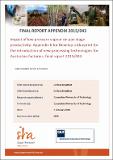Impact of low pressure vapour on pan stage productivity : final report 2015/043
Appendix 6 : develop a blueprint for the introduction of new processing technologies for Australian factories
Abstract
Australian pan stages predominantly use large unstirred batch pans which make it difficult to reduce the process steam consumption of the factory to below 38 to 40% on cane, as these pans typically require process steam (at 200 kPa abs) or vapour 1 (at a minimum of 180 kPa abs) for efficient operation. Continuous pans can operate effectively on vapour 2 (at say 120 kPa abs) or even vapour 3 on certain duties, and so substantial savings in process steam can be obtained through the use of continuous pans. In general, unstirred batch pans of the conventional design in Australian factories cannot operate on low pressure vapour without incurring major operational problems such as poor exhaustions and long cycle times (or reduced capacity). Poor exhaustion of high grade massecuites results in increased massecuite production loadings because of the increased recirculation of sucrose in the A and B molasses. Poor exhaustion of C massecuite results in increased sucrose loss to final molasses and reduced shipment sugar production.

